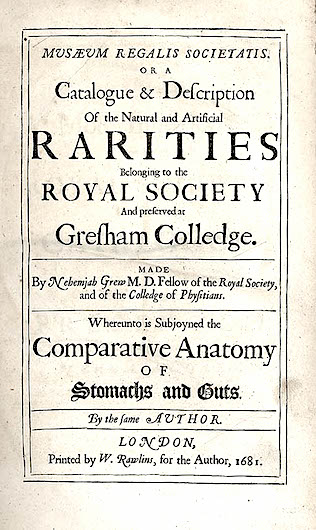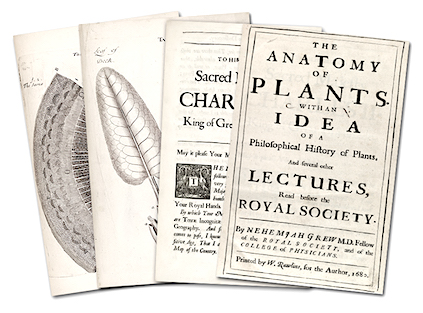In this episode of P&P we’ll take a look at the life and career of the aptly named Nehemiah Grew, the “Father of Plant Anatomy”.

1641-1712
Nehemiah Grew was born on September 26, 1641 in Warwickshire, UK. He graduated from Pembroke College, Cambridge in 1661 and ten years later was awarded a MD degree from Leiden University in the Netherlands.
His interest in plant anatomy began to bud in 1664. In 1670 his essay, The Anatomy of Vegetables begun, was shared with the Royal Society and resulted in his election to the membership.
By 1672 he’d put down roots in London and soon had a large medical practise. Even though he was busy with his career as a physician he still found time over the next decade to write a couple of books, a few short publications on botany and several papers one of which has the intriguing title, “Comparative Anatomy of Stomachs and Guts” and was included in his “Catalog and Description of Rarities” publication, ca. 1681.

In 1682 his tome, “The Anatomy of Plants begun as a philosophical history of plants“, was published. It’s largely a collection of previous publications and is divided into four books, Anatomy of Vegetables begun, Anatomy of Roots, Anatomy of Trunks and Anatomy of Leaves, Flowers, Fruits and Seeds. It has eight-two illustrated plates and an appendix of seven papers which deal mainly with chemistry.
The book is noted for its descriptions of plant structure, a fairly unknown thing at that time. Grew described nearly all the key differences of stem and root morphology and showed that the flowers of the Asteraceae family are composed of multiple tiny tube flowers (florets). The most amazing of his discoveries was that plants reproduce sexually and that flowers are sexual organs. He distinguished and assigned “roles” to the calyx, corolla, pistils, and stamens.

Grew is remembered for being one of the first to establish the observational basis for botany and is noted for his detailed descriptions of plant anatomy. He utilized the microscope (invented in 1590) for his plant anatomy explorations and was a pioneer in this field. His book “Anatomy of Plants…” contains the first known microscopic description of pollen. He discovered that although all pollen is roughly globular, its size and shape varies between species; however pollen grains within a species are all alike. This discovery is central to the field of Palynology, “the study of dust”, which is the study of pollen and particulate samples both organic and inorganic.

Source
Grew’s research technique was based on his adherence to observations and avoidance of explanations invoking occult, hidden or vital forces, or signatures. He also avoided the direct hand, intervention, or guidance by God or other spiritual beings.
He embraced a mechanical and natural philosophy which permitted him to think much like an engineer or how to make the most out of the materials at hand. This engineering concept was theologically acceptable during his time.
Why is this significant?
This ‘Mechanical way’ and Grew’s own theory of “Organ-ism”, that plants possess organs and structure, was outside the bounds of most of the thinking of his time. Before the 17th century it wasn’t certain that plants had much internal structure and that distinct parts or organs played distinct roles. It was often thought that the external shape of a plant was a clue or signature to its use, re: Doctrine of Signatures. But whether there was anything resembling organs in plants was contested. Grew’s detailed illustrations help dispel that belief and bring the study of plants into the scientific world.

Source
In honor of Nehemiah’s work and role as a founder of modern botany, Carl Linnaeus named the genus Grewia after Nehemiah Grew. Grewia is in the Malvaceae family and can be found in several areas including Africa, India, and Australia where it has naturalized and become invasive.
Its fruit comes in both sweet and tart varieties and is used for food and beverages. Other parts of the plant have been used medicinally.

Image by Giuseppe Mazza
Like to know more?
Part 1 | Christoffer Basse Eriksen: Nehemiah Grew and the Making of the “Anatomy of Plants” (1682) – Lecture
Part 2 | Christoffer Basse Eriksen: Nehemiah Grew and the Making of the “Anatomy of Plants” (1682) – Response & Panel Discussion
So interesting love this stuff.